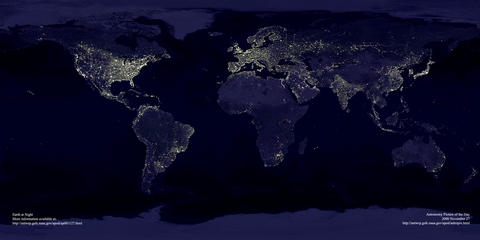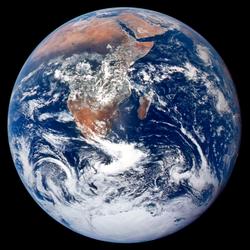As metabolic organisms, we are in the business of using energy to take matter (food and raw material) and create order (bodies and products). In the process, which is inherently cyclical, we generate heat and by-products (not "waste!") that other living organisms utilize. Since we all desire to sustain this business, we must consider how energy and natural resources are distributed on our planet, how they are cycled naturally, and how we can be part of the cycles without breaking the Earth system. Our exponential population growth and our aspirations to increased standards of living underscore the urgency of these considerations.
There are only 3 sources of energy available to earthlings. Radiation from the sun is far and away the biggest source. Secondary sources are gravitational and nuclear.
About 1370 W/m2 of solar energy reaches the earth's upper atmosphere. Since about 20% is reflected back out into space, a good rule of thumb is that about 1 kW/m2 reaches the earth's surface. Given the radius of the earth (6370 km) and remembering that the sun only shines on 1 side of the planet at a time, we can calculate the total solar power reaching the earth's surface and compare it with the magnitudes of other power sources:
Psun = surface area in meters * power/m2 / 2 sides of the planet
= [4*pi*(6,370,000 m)^2] * 1000 W/m2 / 2
= 2.5 *10^17 W, or (since the prefix for 10^15 is "peta") 250 petawatts
= 250 PW
Once on earth, solar energy is stored and transported in many ways.
Most of it turns into heat. Some of it is converted to chemical
energy by plants. It warms the air and causes wind. Because 71% of
the earth's surface area is ocean, lots of solar energy is
absorbed by sea water. The heating of water causes evaporation, so
when the wind carries water vapor over the continents and rain falls,
any hydropower derived from the flow of fresh water can be attributed
to the sun. Even fossil fuel power is solar power. The fuel comes from
fossilized life (ultimately plants) that got its energy long ago
directly from the sun. [Thomas Gold argues alternatives...]
Energy exchange with moon and sun (tidal).
Mass differentiation (nuclear)
Where does energy accumulate? (seque/link to renewable resource maps?) Pie chart of global power? Energy density? Wavy coasts have 40-70kW/m...
Natural resources and distribution?
Human impacts? (New page?) Global warming (Link current state of science to ideas like those in this LA Times Article). Ozone depletion.
This map portrays the distribution of anthropogenic radiation from earth. Could it be that one day, humanity will take over the role of wind and ocean, distributing solar energy from equator to poles? Perhaps then human population density will be more uniform. Even now we seem to huddle near the sea, rarely illuminating the cold, high mountains or vast, open deserts.
Click for much higher resolution image (400kB)

This image of the Earth was acquired by an Apollo astronaut. What patterns do you discern on the land and in the ocean? What processes do you think generated the patterns that you detect? Click on the image to view our home at a much higher resolution...
Image source: NASA Earth Observatory